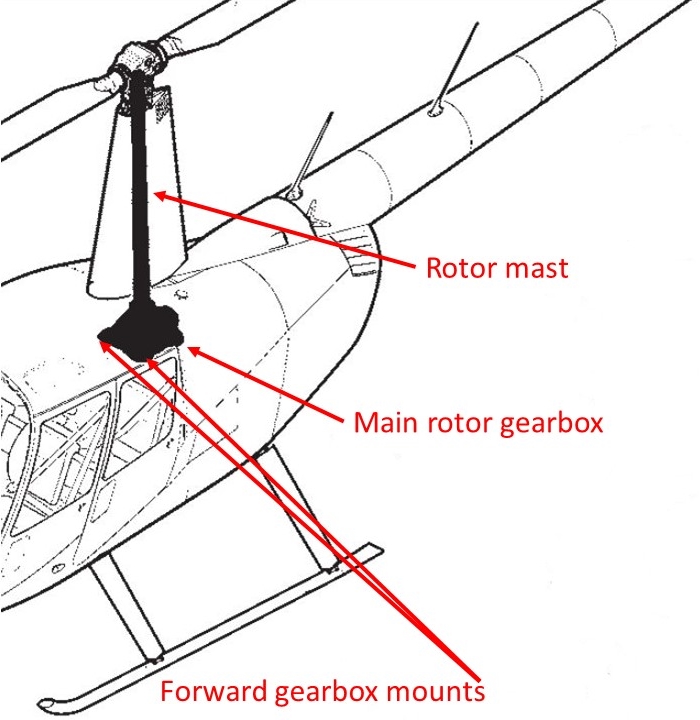What happened
On 18 August 2017, the pilot of a Robinson R44 II helicopter, registered VH-LGN, was conducting a private flight from Noonamah, Northern Territory (NT) to Channel Point, NT, with three passengers on board. At about 1400 Central Standard Time,[1] after a 20-minute flight, the helicopter was flying about 500 ft above a beach at Channel Point in preparation for landing. Weight and balance information provided by the pilot indicated that the helicopter’s centre of gravity was toward the forward limit but within the allowable range.
The pilot reported that the helicopter’s airspeed was about 50 kt as he commenced a descending right turn, intending to land on the beach. During this time, a ‘bounce’ developed through the airframe. The pilot initially moved the cyclic[2] aft to reduce airspeed, the bounce increased to a violent shaking, both fore and aft, and side to side. The pilot then moved the cyclic forward to increase airspeed and lowered the collective,[3] with the intent to conduct an immediate landing.
Just prior to landing, the pilot raised the collective and flared the helicopter. Despite this, the helicopter landed heavily, damaging the skids and the main rotor blade severed the tail boom. The helicopter stopped in an upright position and all four occupants vacated the helicopter without injury.
Related occurrences
The nature of the airframe shaking, as described by the pilot, was similar to an occurrence investigated by the United States National Transportation Safety Board (NTSB) (ANC09GA040) in 2009. In that occurrence, the pilot described severe vibrations and oscillations to the point where the pilot felt like the helicopter was going to come apart. The pilot conducted an emergency landing and landed hard, with the main rotor contacting the tail boom. The NTSB report noted several other similar occurrences of severe airframe vibration from 2006 and 2007, which also resulted in the pilots conducting emergency landings. The vibrations or oscillations have also been referred to as ‘mast rocking’ or ‘chugging’.
Based on information provided by Robinson Helicopters, the NTSB report indicated that the oscillation was associated with fore and aft movement of the rotor mast (Figure 1). The manufacturer had conducted flight tests related to the oscillations and determined that they ‘may develop during operation at high gross weight, at about 90-100 kt airspeed’. Additionally, the tendency to develop oscillations was exacerbated by flying with a forward centre of gravity (although still within the approved envelope) and by entering a 30° left banked turn. A right banked turn could also exacerbate the oscillation, but it was more easily initiated in a left turn.
The mast oscillation was attributed to lack of firmness of newly-installed gearbox mounts and the manufacturer introduced stiffer mounts (part number A653-2) in June 2007 to counter the problem. The rubber in the mounts was found to harden with heat and compression during service and the issue was therefore more likely to affect low-hour helicopters. As such, there was only a requirement to change to the new, stiffer mounts during routine replacement of the original (A653‑1) parts.
In relation to oscillations, the following information was incorporated as Safety Tip 19 in the Robinson R44 Pilot’s Operating Handbook (October 2011):
Use caution when loading the helicopter near the forward CG limit and remember that CG shifts forward as fuel is burned. Near the forward CG limit, a fore-aft oscillation may develop during steep turns or autorotations. To stop this oscillation, return to straight and level powered flight. Oscillation may take several seconds to dissipate.
Figure 1: Location of the main rotor gearbox and forward gearbox mounts

Source: Robinson Helicopter Company, modified by the ATSB
Helicopter maintenance
Review of maintenance documentation showed that VH-LGN had 1,609 hours total time in service and 45 hours since the last 100-hour inspection on 14 July 2017. The airframe logbook indicated that replacement of the main rotor gearbox transmission mounts was conducted at that service. The airframe logbook recorded that the forward main rotor gearbox transmission mounts were replaced with the incorrect (superseded) part number A653-1, instead of the required A653-2 parts.
The A653-1 and A653-2 parts were the same size and shape. They were distinguished by the -2 parts having a large, handwritten ’H’ in yellow ink on the top and edge of the mount (Figure 2), in addition to the labelling on the parts’ packaging. The availability of the -1 part was due to their continued installation on the smaller, Robinson R22 helicopters. The engineer who had changed the mounts had referenced the correct maintenance information at the time, but was unable to recall or reconcile the circumstances that resulted in him obtaining and fitting the incorrect part number mounts.
Figure 2: A653-2 gearbox mount installed

Source: Robinson Helicopter Company
Analysis
The onset of the mast oscillations, as described during this occurrence, was largely consistent with the flight conditions described in Safety Tip 19 in the Robinson Pilot’s Operating Handbook. While the pilot’s actions in this occurrence did not follow the recommendation listed in the Safety Tip, his actions were consistent with those from previous occurrences and also in accordance with Safety Tip 7, which recommends making a safe landing if unusual sound or vibration begins in flight.
Incorrect forward main rotor gearbox mounts were installed in the R44 helicopter during recent maintenance. The manufacturer had previously found that these softer forward gearbox mounts increased the likelihood of the onset of oscillations associated with mast rocking in Robinson R44 helicopters. The onset of the airframe oscillations experienced by the pilot in this occurrence were therefore consistent with the manufacturer’s findings.
The circumstances that resulted in the installation of the incorrect parts was not clear. However, this type of error highlights the importance of extra vigilance around visually and dimensionally‑similar parts.
Findings
These findings should not be read as apportioning blame or liability to any particular organisation or individual.
- As the pilot commenced a descending right turn, the unexpected onset of severe fore and aft mast oscillations resulted in the pilot conducting an immediate landing that significantly damaged the helicopter.
- The maintainer had inadvertently installed incorrect forward main rotor gearbox mounts, which had previously been found to contribute to the initiation of fore and aft mast oscillation.
Purpose of safety investigationsThe objective of a safety investigation is to enhance transport safety. This is done through:
It is not a function of the ATSB to apportion blame or provide a means for determining liability. At the same time, an investigation report must include factual material of sufficient weight to support the analysis and findings. At all times the ATSB endeavours to balance the use of material that could imply adverse comment with the need to properly explain what happened, and why, in a fair and unbiased manner. The ATSB does not investigate for the purpose of taking administrative, regulatory or criminal action. TerminologyAn explanation of terminology used in ATSB investigation reports is available here. This includes terms such as occurrence, contributing factor, other factor that increased risk, and safety issue. Publishing informationReleased in accordance with section 25 of the Transport Safety Investigation Act 2003 Published by: Australian Transport Safety Bureau © Commonwealth of Australia 2018
Ownership of intellectual property rights in this publication Unless otherwise noted, copyright (and any other intellectual property rights, if any) in this report publication is owned by the Commonwealth of Australia. Creative Commons licence With the exception of the Coat of Arms, ATSB logo, and photos and graphics in which a third party holds copyright, this publication is licensed under a Creative Commons Attribution 3.0 Australia licence. Creative Commons Attribution 3.0 Australia Licence is a standard form licence agreement that allows you to copy, distribute, transmit and adapt this publication provided that you attribute the work. The ATSB’s preference is that you attribute this publication (and any material sourced from it) using the following wording: Source: Australian Transport Safety Bureau Copyright in material obtained from other agencies, private individuals or organisations, belongs to those agencies, individuals or organisations. Where you wish to use their material, you will need to contact them directly. |
__________
- Central Standard Time (CST): Coordinated Universal Time (UTC) + 9.5 hours.
- Cyclic: a primary helicopter flight control that is similar to an aircraft control column. Cyclic input tilts the main rotor disc, varying the attitude of the helicopter and hence the lateral direction.
- Collective: a primary helicopter flight control that simultaneously affects the pitch of all blades of a lifting rotor. Collective input is the main control for vertical velocity.



